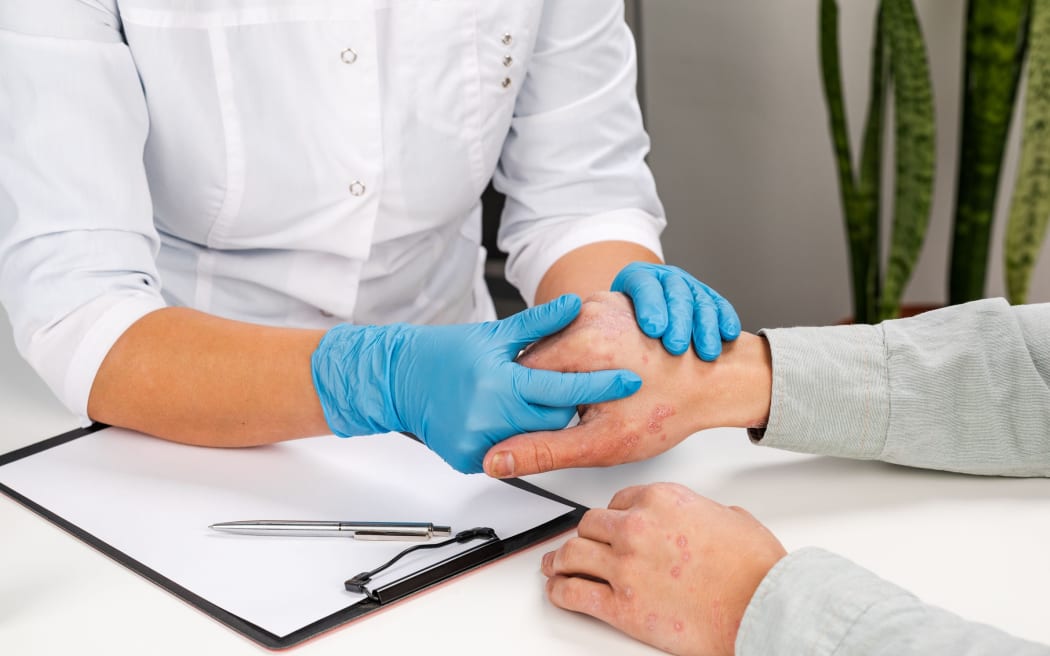
There are about 18 full-time dermatologists in the public health system, but based on population size New Zealand should ideally have close to 100 dermatologists, the New Zealand Dermatological Society says. Photo: 123RF
People suffering debilitating and potentially life-threatening skin conditions are not getting the treatment they need in many regions due to the dire shortage of dermatologists.
According to Te Whatu Ora data, more than 37 percent of dermatology patients waited longer than four months for a first specialist appointment in January - but that varied locally from fewer than 2 percent in Canterbury to 100 percent of Northland patients.
Mark* - not his real name - developed severe eczema as a young teenager and it affected every part of his life, disrupting his education, limiting his career choices, social and family life.
He knows of people in some regions waiting 10 months or more to see a specialist, but if he has a flare-up, specialists in Auckland try to fit him in within a couple of weeks.
"If you're in the system and you're known to them, it won't take too long. I can't complain. But it's still long enough, when you're in pain and discomfort."
He would be much worse off without the support of his wife and family, he said.
"If you don't have a support person there to be aware of how you're doing mentally and physically, people will just be hidden away and never show their faces to the world."
Mark's wife has been his carer for over 20 years, as well as doing a lot of the hands-on parenting for their children and being the sole wage-earner at times.
When his skin is too inflamed to work, he has spent periods of time on the sickness benefit.
His wife said eczema had to be factored into "every decision, every day".
"It's just something that you're constantly aware of, trying to balance everything can be quite difficult: making sure the right washing powder is used, making sure everything is clean and sanitised, making sure he gets the care he needs, on top of the kids, the house, the job... so yes, it's a pretty big component of our lives."
Dermatology services 'struggle to meet demand'
New Zealand Dermatological Society co-president Dr Louise Reiche said the ideal ratio was about one specialist dermatologist for 80,000 people.
"In New Zealand that would give us close to 100 dermatologists, and we have about 18 full-time dermatologists in the public health system."
Ten years ago a report by Health Workforce New Zealand found access to publicly funded dermatology services was very poor, and called for "urgent action".
But specialists say the situation has got worse since then, especially since Covid.
In 2022, an internal Health Ministry report said services were "untenable" due to workforce shortages, and improving them was "a matter of urgency".
It outlined a plan for a "hub and spoke" model with four main centres to provide a consistent service nationwide and build medical, nursing and allied health workforce capacity.
Dr Paul Jarrett, ex-president of the Dermatological Society, was involved in developing that plan and has spent years advocating for better services to three previous health ministers, ministry officials and lately Te Whatu Ora and its board.
"The services that are around struggle to meet demand. And where there are insufficient staff numbers, the service will quickly become overwhelmed and burn-out is a real problem," he said.
"I suspect this is a microcosm of the wider problems facing the public sector at present."
New Zealand has the highest rate of skin cancers in the world.
Dr Reiche said GPs were becoming increasingly skilled at picking up cancers, and those patients were rightly prioritised.
However, there were other conditions that needed specialist attention, she said.
"It's not just skin cancers that can be life-threatening for patients but there are some significant skin disorders - fortunately rare - that can actually kill. So being able to recognise them and act quickly can be life-saving."
Dr Jarrett said there were others whose lives were blighted by chronic skin conditions.
"People with severe inflammatory skin disease have awful quality of life, it's terrible for some of them.
"It's on a par with people living with bad heart failure."
Like many specialty services across the health system, dermatology is experiencing staffing challenges throughout the motu.
Patients prioritised on clinical need - Health NZ
In a statement to RNZ, Health New Zealand Te Whatu Ora said it was taking steps to support the growth and retention of the medical workforce, including specialists.
"Dermatologists are a very small and specialised medical workforce and account for around 30 people nationally (at around 22 full-time equivalent)," the spokesperson said.
"We know we currently have three vacancies across Dermatology currently."
Dermatology patients were seen by multi-disciplinary teams, consisting of consultants, registrars, nurse specialists, and dermatology nurses, from primary care through to hospital services.
"As always, patients are prioritised based on clinical need, with those needing urgent care seen first, followed by semi-urgent and routine referrals.
"Further work is underway to develop training opportunities for clinicians and to introduce systems or technologies which increase the speed and capacity of the service."





